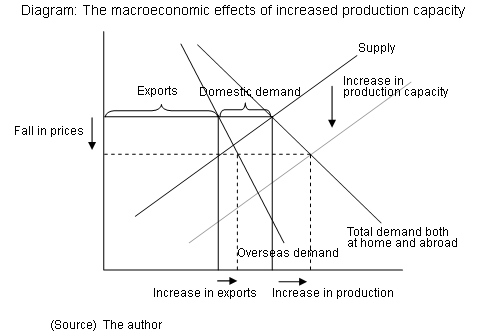The Chinese economy, which was reportedly overheating since 2003, is now showing increasing signs of deflation, visible in such areas as sluggish consumer prices. The investment boom of past years has brought about production capacity that surpasses demand in many industries, and corporate earnings in the manufacturing sector are being squeezed by falling output prices. Many companies are seeking a way out of this situation by increasing exports, but the resulting surge in China's trade surplus is giving rise to trade frictions, and the export environment is worsening.
Among the sectors where there are visible signs of excess production capacity, the situation is most serious in the steel, electrolytic aluminum, charred coal and automobile industries. According to Mr. Ma Kai, minister of the National Development and Reform Commission, production capacity in the steel industry already exceeds demand by 120 million tons. The total production capacity under construction reaches 70 million tons, and that currently planned comes to another 80 million tons. As for electrolytic aluminum, the current production capacity is 10.3 million tons, but 2.6 million tons of that stands idle. In the charred coal industry, production capacity exceeds demand by 100 million tons, and the total production capacity of factories under construction or to be constructed comes to 30 million tons. In the automobile sector, production capacity exceeds demand by 2 million units. Plants under construction can reportedly manufacture another 2.2 million units, and a proposed capacity can churn out another 8 million vehicles.
The direct cause for this excessive production capacity is the increase in investment. In fact, the ratio of capital formation to gross domestic product has continued to rise in recent years, and should have topped 45% in 2005, the highest level in the world. The factors behind this rise are as follows.
First, the economic environment that China faces at home and abroad has improved as the Asian currency crisis comes to an end. Among the factors greatly contributing to the increase in investment are: 1) the rise in direct investment around the time China joined the World Trade Organization at the end of 2001 based on expectations that it would become an attractive market in the future; 2) robust investment demand in the areas of infrastructure and construction due to national projects such as the 2008 Beijing Olympics and the 2010 World Exposition in Shanghai; 3) an improvement in corporate earnings and the investment environment due to progress in reforms of state-owned and group-owned enterprises that in turn led investment to shift from the traditional light industries to the materials, energy and machinery sectors and 4) the 10th Five-year Plan from 2001 that placed emphasis on urbanization and designated sectors such as housing, automobiles and high-tech as new growth industries.
A distorted price system is also fueling excessive investment. China's shift toward a market economy is being realized by having the goods and services markets transform first. As such, there is still much government intervention in the markets for factors of production, and the price mechanism that reflects supply and demand is not yet functioning sufficiently. Returns on investment are especially high because land prices and wages are kept lower than market equilibrium levels. Furthermore, in the case of state-owned enterprises, soft budgetary constraints -- their ability to receive government compensation through such means as a reduction or forgiveness of debts even if they fall into the red -- exacerbate demand for funds.
What is more, government measures to clamp down on the investment overheating that became conspicuous from 2003 were insufficient. The central government came out with a policy to step up measures to curb investment, but was unable to fully enforce it due to resistance from local governments.
Amid a situation where domestic supply exceeds domestic demand as a reflection of excessive production capacity, while on the one hand prices are falling and corporate earnings are suppressed, companies must look to overseas markets as an outlet for their products (diagram). In the case of steel materials, prices are about 20% lower than at their peak in early 2005, and in reflection of this, profits at steel firms in January-October 2005 rose only 11.2% year-on-year, sharply lower than the 63.4% growth logged for the same period in 2004. Meanwhile, exports of steel products during that same period in 2005 showed a year-on-year surge of 69.1% (in volume terms). Similar trends can be observed in many other industries. As a result, China's trade surplus in 2005 topped $100 billion and is continuing to rewrite the record books. The surge in its trade surplus vis-a-vis the United States especially is not fueling only trade friction but also pressure to further revalue the yuan.
Recognizing the seriousness of the situation, the authorities have started to take such steps as limiting new investment in certain sectors, doing away with old equipment and merging and closing inefficient plants. However, when we consider that the fundamental factor behind the excess production capacity is the inappropriate investments made amid an immature market environment, China needs to rush to implement reforms to establish a well-functioning market economy through such means as privatizing state-owned enterprises and banks and changing the role of the government.



